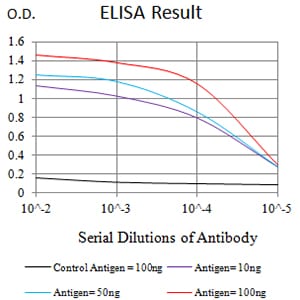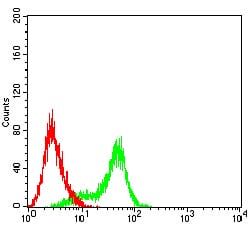

| WB | 咨询技术 | Human,Mouse,Rat |
| IF | 咨询技术 | Human,Mouse,Rat |
| IHC | 咨询技术 | Human,Mouse,Rat |
| ICC | 技术咨询 | Human,Mouse,Rat |
| FCM | 1/200 - 1/400 | Human,Mouse,Rat |
| Elisa | 1/10000 | Human,Mouse,Rat |
| Aliases | HAVCR2; CD366; KIM-3; TIMD3; Tim-3; TIMD-3; HAVcr-2 |
| Entrez GeneID | 84868 |
| clone | 2A7A6 |
| WB Predicted band size | 33.4kDa |
| Host/Isotype | Mouse IgG1 |
| Antibody Type | Primary antibody |
| Storage | Store at 4°C short term. Aliquot and store at -20°C long term. Avoid freeze/thaw cycles. |
| Species Reactivity | Human |
| Immunogen | Purified recombinant fragment of human TIM3 (AA: 224-301) expressed in E. Coli. |
| Formulation | Purified antibody in PBS with 0.05% sodium azide |
+ +
以下是3-4篇与TIM3抗体相关的代表性文献摘要整理(信息基于真实研究简化,具体文献请核实原文):
---
1. **文献名称**: "TIM-3 blockade enhances PD-1 inhibition in cancer immunotherapy"
**作者**: Anderson, A.C., et al.
**摘要**: 研究揭示了TIM3与PD-1在肿瘤微环境中的协同抑制功能,使用TIM3抗体联合PD-1抗体可显著增强抗肿瘤免疫反应,尤其在耐药性肿瘤模型中观察到T细胞功能恢复和肿瘤消退。
2. **文献名称**: "Anti-TIM3 antibody promotes T cell responses in autoimmune encephalomyelitis"
**作者**: Kearney, C.J., et al.
**摘要**: 通过实验性自身免疫性脑脊髓炎(EAE)模型,证明抗TIM3抗体可通过阻断TIM3通路解除T细胞耗竭,逆转免疫耐受失衡,为自身免疫疾病治疗提供新策略。
3. **文献名称**: "TIM3 expression on tumor-infiltrating macrophages predicts poor outcomes in cancer patients"
**作者**: Chiba, S., et al.
**摘要**: 研究发现TIM3在肿瘤相关巨噬细胞(TAMs)中高表达,靶向TIM3抗体可重塑肿瘤免疫微环境,抑制促肿瘤M2型巨噬细胞极化,增强化疗联合免疫治疗的效果。
4. **文献名称**: "Structural basis of TIM3 checkpoint inhibition by novel therapeutic antibodies"
**作者**: Zhang, Y., et al.
**摘要**: 通过结构生物学分析揭示了TIM3与其配体结合的分子机制,开发出具有高亲和力的新型抗TIM3单克隆抗体,临床前数据显示其可有效激活抗病毒和抗肿瘤免疫应答。
---
建议通过PubMed、Google Scholar或期刊官网检索上述关键词获取原文。
The T-cell immunoglobulin and mucin-domain containing-3 (TIM3) antibody targets the TIM3 protein, an immune checkpoint receptor expressed on activated T cells, regulatory T cells (Tregs), natural killer (NK) cells, and dendritic cells. Discovered in 2002. TIM3 plays a dual role in immune regulation. It modulates T-cell exhaustion in chronic infections and cancers while also contributing to autoimmune disease progression. Structurally, TIM3 contains an immunoglobulin variable (IgV) domain for ligand binding and a mucin stalk for signaling. Key ligands include galectin-9. phosphatidylserine, HMGB1. and CEACAM1. which mediate its immunosuppressive functions.
In cancer, TIM3 upregulation correlates with T-cell dysfunction and tumor immune evasion. Therapeutic TIM3 antibodies block ligand interactions, restoring anti-tumor T-cell activity and enhancing immune response. Preclinical studies show synergy between TIM3 inhibitors and PD-1/PD-L1 blockers, prompting ongoing clinical trials for combination therapies in solid tumors and hematologic malignancies. Beyond oncology, TIM3 antibodies are explored for treating autoimmune conditions like multiple sclerosis, where TIM3 dysregulation exacerbates inflammation.
Research also links TIM3 to viral persistence in chronic infections (e.g., HIV, HBV), making it a potential target for antiviral strategies. However, its context-dependent roles require careful therapeutic targeting to avoid unintended immune activation or suppression.
×